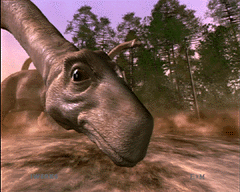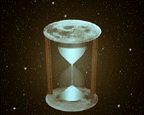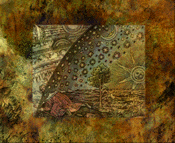It has been said that four countries have provided leadership in 3-D computer animation: the United States, Japan, Canada and France. One could expand that list to include other countries, such as England; but in any case,France is certainly one of the leaders.
It has been said that four countries have provided leadership in 3-D computer animation: the United States, Japan, Canada and France. One could expand that list to include other countries, such as England; but in any case, France is certainly one of the leaders.

A Little Bit of History
Three-D computer animation is not new in France. Its history goes back to the 1960s and the experimental works of Peter Foldes at Service de recherche de l'ORTF, an experimental art/technology lab run by Pierre Schaeffer. (Its beginning, of course, actually dates back to the flight simulators used by the French Army, which are much the same as those that now run on personal computers.) Soon after, a firm called Sogitec emerged from this prehistoric period and eventually became the largest company of its kind in Europe, and is now known as Ex Machina.
At the time, more than 15 years ago, the computers being used were big, expensive and slow. The pictures Sogitec/Ex Machina generated were flat, ugly and expensive. Very few classically trained were interested in this new way of making films.
In the early 1980s, the French government gave a lot of money to spur the growth of this new industry and a film festival, Imagina, was set up to showcase 3-D pictures from all around the world.
Production companies, and especially post-production companies, began to buy equipment to produce 3-D pictures for TV commercials and advertising. They used, and still use today, a very complete software package called Explore, from Thomson Digital Image (a division of Thomson, a French company specializing in computer and hi-fi equipment). And when these companies could not find the right software to create the images they wanted, they wrote one themselves.
Today's Hardware and Software
As is customary elsewhere, a variety of software is used in France. A large percentage run on Silicon Graphic work stations, a platform that uses the old, but powerful Unix operating system. It is a very flexible platform, which allows each individual animator to customize his or her own setup with small, personalized programs. The amount of software that runs on UNIX is large and today even includes small applications written for personal computers. These work stations are often linked with PCs and Macintoshes, where one can prepare the "maps" (the textures you can see on the shapes of the 3-D objects). Frequently, several programs are used in making a single film: each one has its own niche, as an all-purpose software still doesn't exist.
The hardware and software used today are the same around the world. The main exception being the in-house software developed for internal use at various companies. For instance, MacGuffline has developed an excellent program to do morphing; Duran has a program that quickly integrates several layers of imagery, while Ex Machina has one that one can handle muscle distortion; K.O. Kid was made at Buff with software that creates an animation of a "3-D flat" character; etc., etc.
Who Works in 3-D?
Different kind of people work in 3-D: There are those who model the shape and volume of objects (an object can be anything you want-a character, an animal, furniture, etc.), others paint textures, animate and do the lighting.
For complicated shapes (like animals), artists start by sculpting the objects with plaster. Then, the object "appears" in the computer by inputting coordinates from a series of points drawn on the shape with a special pen linked to the computer.
Today, more and more traditionally trained animators are coming into 3-D animation. An increasing number of artists who create textures come from a traditional painting background. In other words, these two separate worlds are now becoming one. The war between the two universes (traditional/computer) is over.

Latest Techniques
There is a new way to animate, known as motion capture, which has been around for a few years. It's a kind of "rotoscoping" that involves shooting a real person in a special studio, with sensors attached to key points on the body (with some on the clothes or even the skin). The system provides a computer all a person's coordinates while he or she is moving, which can then be reproduced by the computer with great accuracy. The interesting thing, of course, is that you can change the character while keeping the movements intact; for instance, a realistic dancer can be turned into a cartoon one, while continuing to do the same dance.
Another interesting development, in the field of virtual reality, is being done at MediaLab. Every day, in France, you can see puppets being animated in real time on the Canal+ cable network. Two classical puppet animators wearing data gloves make the character act: one handles body movements, the other works on the face. Of course, this sort of technique needs a very powerful computer. More amazing, though, is that the system is used with an interactive TV game: the players, sitting at home, call in to indicate the route a pizza delivery man has to take through a city "built" just for the game, which is seen in 3-D, in real time.
MediaLab, as its name implies, is a kind of laboratory that specializes in TV production. In the field of virtual reality and real time 3-D animation, they probably have a two or three year lead over everybody else.
Another spectacular system was created by I.N.A. (Institute National de l'Audiovisuel). A background, a car, or any other solid object is photographed, with several graphic targets included on the field or the object itself. A computer then analyzes the movement with absolute accuracy and you can then change whatever you want. For instance, you can put a synthetic car in real landscape (like in a film made for Renault, the French automobile company), or you can do the exact opposite and create a 3-D landscape for a real car (used for advertising Italy's Lancia). I worked on these projects and I can assure you that the system is very impressive.

So, What About the Pictures?
Companies specializing in 3-D each have their own unique styles. If you want to generate a ride (dynamic cinema) the power of Ex Machina is the best. If you want to do special effects for 35mm theatrical films, Duran has the most experience (they just won a prize at Imagina for their work on La cite des enfants perdus - The city of the lost chidren).
The principal markets for these companies, which include both the domestic and international markets, are: advertising films (including TV commercials) done on videotape or 35mm film; the occasional industrial film; special effects for feature films; TV specials; and films used for theme park rides and exhibitions. Several studios work on video games, with the most important company in this area being Cryo.
In Europe, France's major competitors are Great Britain, Italy, Germany and Switzerland; other European countries have 3-D computer animation industries, but most highly developed are in the UK or France. It is to these two countries that European producers usually come to get to realize their projects.
The Future?
Things have changed considerably since the first experiments came out of the labs in the 1960s. We are now in the industrial age of computer animation.
It's difficult to guess what the future will be. The more advertising agencies and film producers use these techniques, the more it will generate new talent and fuel its growth. With the proliferation of personal computers, more and more independent animators are bound to explore this fascinating world. Art schools now include special courses in this area; prestigious schools, such as the Ecole des Beaux Arts de Paris and the Ecole des Arts Decoratifs, have 3-D computer animation departments. Several general consumer magazines, including some in television, provide an increasing amount of information to the public at large. The future is already here. The doors are wide open. We just have to make it live.
Olivier Cotte is a Paris-based director and computer animation artist, whose credits include Terra Igconita.







